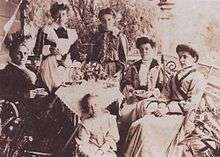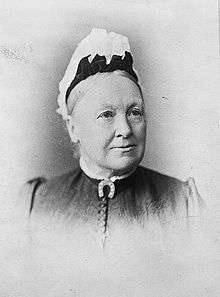Women in Australia
 Australian women having tea on a verandah in 1910 | |
| Gender Inequality Index[1] | |
|---|---|
| Value | 0.113 (2013) |
| Rank | 19th out of 152 |
| Maternal mortality (per 100,000) | 7 (2010) |
| Women in parliament | 29.2% (2013) |
| Females over 25 with secondary education | 94.3% (2012) |
| Women in labour force | 58.8% (2012) |
| Global Gender Gap Index[2] | |
| Value | 0.7390 (2013) |
| Rank | 24th out of 144 |
Women in Australia have been described as to be "more independent and self-reliant than those in some other countries". They have rights, status and opportunities that are conferred to Australian men. Historically, a masculine bias has dominated Australian culture.
History
Settlement

Early colonial administrations were anxious to address the gender imbalance in the population brought about by the importation of large numbers of convict men. Between 1788 and 1792, around 3546 male to 766 female convicts were landed at Sydney.[3] Women came to play an important role in education and welfare during colonial times. Governor Macquarie's wife, Elizabeth Macquarie took an interest in convict women's welfare.[4] Her contemporary Elizabeth Macarthur was noted for her 'feminine strength' in assisting the establishment of the Australian merino wool industry during her husband John Macarthur's enforced absence from the colony following the Rum Rebellion.[5]
The Catholic Sisters of Charity arriving in 1838 and set about pastoral care in a women's prison, visiting hospitals and schools and establishing employment for convict women. They established hospitals in four of the eastern states, beginning with St Vincent's Hospital, Sydney in 1857 as a free hospital for all people, but especially for the poor.[6] Caroline Chisholm (1808–1877) established a migrant women's shelter and worked for women's welfare in the colonies in the 1840s. Her humanitarian efforts later won her fame in England and great influence in achieving support for families in the colony.[7] Sydney's first Catholic Bishop, John Bede Polding founded an Australian order of nuns—the Sisters of the Good Samaritan—in 1857 to work in education and social work.[8] The Sisters of St Joseph, were founded in South Australia by Saint Mary MacKillop and Fr Julian Tenison Woods in 1867.[9][10][11] MacKillop travelled throughout Australasia and established schools, convents and charitable institutions. She was canonised by Benedict XVI in 2010, becoming the first Australian to be so honoured by the Catholic Church.[12]
1901-1945
.jpg)
Women energetically participated in the war effort, with few signs of defeatism or resistance to government policies.[13] In 1922, the Country Women's Association was formed with the intention to improve the lives of women in rural Australia. It has since expanded to become the largest women's organisation in the country.
Since 1945
In 1974, the Commonwealth Court of Conciliation and Arbitration granted women the full adult wage. However, resistance to women being employed in certain industries remained until well into the 1970s. Because of obstruction from elements of the Unions movement, it would take until 1975 for women to be admitted as drivers on Melbourne's trams, and Sir Reginald Ansett refused to allow women to train as pilots as late as 1979.[14]
Suffrage

Australia had led the world in bringing women's suffrage rights during the late 19th century. Propertied women in the colony of South Australia were granted the vote in local elections (but not parliamentary elections) in 1861. Henrietta Dugdale formed the first Australian women's suffrage society in Melbourne in 1884. Women became eligible to vote for the Parliament of South Australia in 1895. This was the first legislation in the world permitting women also to stand for election to political office and, in 1897, Catherine Helen Spence became the first female political candidate for political office, unsuccessfully standing for election as a delegate to the Federal Convention on Australian Federation. Western Australia granted voting rights to women in 1899.[15]
Edith Cowan was elected to the West Australian Legislative Assembly in 1921. Dame Enid Lyons, was the first woman to hold a Cabinet post in the 1949 ministry of Robert Menzies and finally, Rosemary Follett was elected Chief Minister of the Australian Capital Territory in 1989, becoming the first woman elected to lead a state or territory. By 2010, the people of Australia's oldest city, Sydney had female leaders occupying every major political office above them, with Clover Moore as Lord Mayor, Kristina Keneally as Premier of New South Wales, Marie Bashir as Governor of New South Wales, Julia Gillard as Prime Minister, Quentin Bryce as Governor-General of Australia and Elizabeth II as Queen of Australia.[16]
Historiography
Up until the 1960s the Australian national character was typically masculine.[17] Only in more recent decades has attention been paid to the role and marginal status of women and minority groups. One of the earliest studies on the role of women in Australian culture was conducted by Miriam Dixson in her 1975 study, The Real Matilda.[17] Dixson concluded that there was deep contempt for women in the Australian ethos and that the only role for women was within the family.[17]
Marilyn Lake argues that the first stage of women's history in the 1970s demonstrated an angry tone, with a revolutionary critique that reflected its close connections with the women's liberation movement. By the late 20th century, women's history was less strident and more thoroughly integrated into social history and labor history. In the 21st century, the emphasis has turned to a broader horizon of "gender relations", which includes such concepts as femininity and masculinity.[18]
See also
- Convict women in Australia
- List of Australian sportswomen
- Women and government in Australia
- Women in the Australian military
References
- ↑ "Table 4: Gender Inequality Index". United Nations Development Programme. Retrieved 7 November 2014.
- ↑ "The Global Gender Gap Report 2013" (PDF). World Economic Forum. pp. 12–13.
- ↑ B.H. Fletcher. "Biography – Arthur Phillip – Australian Dictionary of Biography". Adbonline.anu.edu.au. Retrieved 14 July 2011.
- ↑ Barnard, Marjorie. "Biography – Elizabeth Henrietta Macquarie – Australian Dictionary of Biography". Adbonline.anu.edu.au. Retrieved 14 July 2011.
- ↑ Conway, Jill. "Biography – Elizabeth Macarthur – Australian Dictionary of Biography". Adbonline.anu.edu.au. Retrieved 14 July 2011.
- ↑ "St Vincent's Hospital, history and tradition, sesquicentenary – sth.stvincents.com.au". Stvincents.com.au. Retrieved 14 July 2011.
- ↑ Iltis, Judith. "Biography – Caroline Chisholm – Australian Dictionary of Biography". Adbonline.anu.edu.au. Retrieved 14 July 2011.
- ↑ "Sisters of The Good Samaritans". Goodsams.org.au. Retrieved 14 July 2011.
- ↑ "Brothers in Australia". Cfc.edu.au. Retrieved 14 July 2011.
- ↑ "Institute of the Sisters of Mercy of Australia – Who We Are". Mercy.org.au. Retrieved 14 July 2011.
- ↑ http://www.maristoz.edu.au/index.php?option=com_content&view=article&id=18&Itemid=96. Retrieved July 31, 2012. Missing or empty
|title=(help) - ↑ Thorpe, Osmund. "Biography – Mary Helen MacKillop – Australian Dictionary of Biography". Adbonline.anu.edu.au. Retrieved 14 July 2011.
- ↑ Patsy Adam-Smith, Australian Women at War (Thomas Nelson Australia, 1984)
- ↑ Geoffrey Bolton (1990) p. 229
- ↑ "Documenting Democracy". Retrieved 2011-04-21.
- ↑ "AEC.gov.au". AEC.gov.au. 4 December 2007. Retrieved 14 July 2011.
- 1 2 3 Schaffer, Kay (1988). Women and the Bush: Forces of Desire in the Australian Cultural Tradition. Cambridge University Press. p. 5-7. ISBN 0521368162. Retrieved 23 August 2016.
- ↑ Marilyn Lake, "Women's And Gender History In Australia" Journal of Women's History (2013) 25#4 pp 190-211
Further reading
- Alford, Katrina. Production or reproduction?: an economic history of women in Australia, 1788-1850 (Melbourne: Oxford University Press, 1984)
- Damousi, Joy. Women Come Rally: Socialism, Communism and Gender in Australia 1890–1955 (Melbourne: Oxford University Press, 1994)
- Daniels, Kay, So Much Hard Work: Women and Prostitution in Australian History (Sydney: Fontana Collins, 1984)
- Dixson, Miriam. The Real Matilda: Woman and Identity in Australia, 1788 to the Present (Penguin Books Australia, 1984)
- Grimshaw, Patricia, Marilyn Lake, Ann McGrath and Marian Quartly. Creating a Nation (Ringwood: Penguin, 1994); a general history of Australia with emphasis on social history and gender
- Grimshaw, Patricia. “The Australian Family: An Historical Interpretation,” in The Family on the Modern World ed. Alisa Burns, Gill Bottomley, and Penny Jools (Sydney: Allen and Unwin, 1983), pp 31–48.
- Hercus, Cheryl. Stepping out of line: Becoming and being feminist (Psychology Press, 2005) excerpt
- Lake, Marilyn. Getting equal: The history of Australian feminism (Sydney: Allen & Unwin, 1999)
- McMurchy, Megan, Margot Oliver, and Jeni Thornley. For love or money: a pictorial history of women and work in Australia (Penguin Books, 1983)
- Moreton-Robinson, Aileen. Talkin'up to the white woman: Aboriginal women and feminism (Univ. of Queensland Press, 2000)
- Ryan, Edna and Anne Conlon. Gentle Invaders: Australian Women at Work (Melbourne: Penguin, 1975).
- Saunders, Kay, and Raymond Evans, eds. Gender relations in Australia: Domination and negotiation (Harcourt Brace Jovanovich, 1992)
- Sheridan, Susan. Along the Faultlines: Sex, Race and nation in Australian Women’s Writing 1880s–1930s (St Leonard, Australia: Allen and Unwin, 1995).
- Summers, Anne. Damned Whores and God’s Police: The Colonization of Australian Women (Melbourne: Penguin, 1975),
Historiography
- Damousi, Joy, and Marilyn Lake, eds. Gender and War: Australians at War in the Twentieth Century (Melbourne: Cambridge University Press, 1995):
- Lake, Marilyn. "Women's And Gender History In Australia" Journal of Women's History (2013) 25#4 pp 190–211 online
Primary sources
- Daniels, Kay, ed. Australia's women, a documentary history: from a selection of personal letters, diary entries, pamphlets, official records, government and police reports, speeches, and radio talks (2nd ed. U of Queensland Press, 1989) 335pp. The first edition was entitled Uphill all the way : a documentary history of women in Australia (1980).
- Teale, Ruth, ed. Colonial Eve: sources on women in Australia, 1788-1914 (Melbourne : Oxford University Press, 1978)
External links
 Media related to Women of Australia at Wikimedia Commons
Media related to Women of Australia at Wikimedia Commons Media related to Women's clothing of Australia at Wikimedia Commons
Media related to Women's clothing of Australia at Wikimedia Commons
